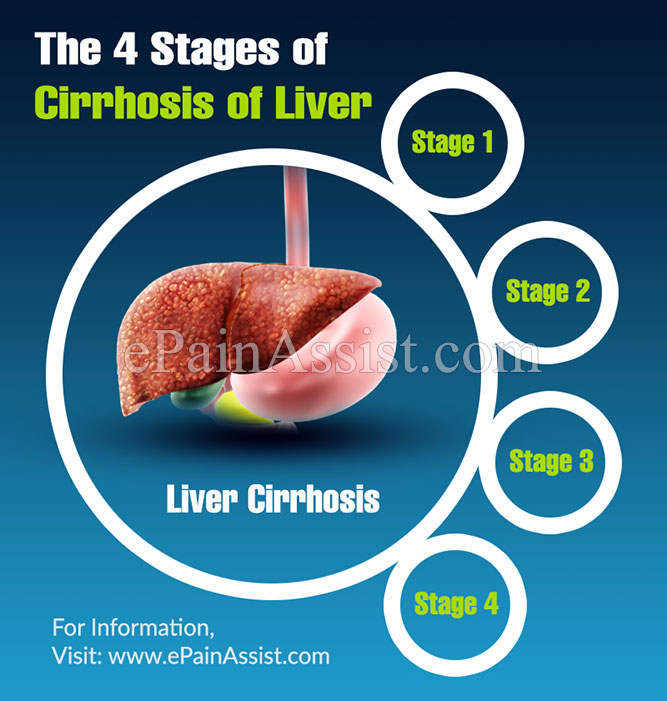Cirrhosis of liver is a critical condition of the liver that is on-going and long term. In this condition, the islands of liver tissue replace the normal structure of the liver. This occurs because scar tissues, which are non-functional, separate the liver tissues and thus, creates the islands of scar tissue within normal liver. As the name suggests, scar tissues create scars in the liver tissue. Therefore, the liver stops functioning normally.
When this occurs for a long period of time and is an on-going condition, it is referred to as liver cirrhosis. If the condition is not stopped and the liver loses its normal capacity to function even to the least, it is referred to as end stage liver disease.
There are various causes behind the occurrence of liver cirrhosis. If you are alcoholic or if you have suffered from hepatitis B and similar other liver diseases, you are likely to develop cirrhosis or liver.1 However, there are 4 stages of cirrhosis of liver that will tell how much damage has already been caused to the liver, if you are already suffering from cirrhosis.2

The 4 Stages of Cirrhosis of Liver
Stage 1 Cirrhosis of Liver:
If you are in the earliest stage of cirrhosis of liver, it will be deemed as Stage 1 Cirrhosis of Liver. At this time, there is usually no sign of liver damage. However, the liver starts to be inflamed. Since the liver is actively inflamed, it tries to heal itself and in this process, it starts to swell up. You will feel fatigue and a lack of energy at this stage and not really understand what is wrong with the liver.
The liver shows no prominent sign of cirrhosis despite the severe damage that has been caused to the liver as there is not enough scar tissue that can potentially show the clinical signs of liver cirrhosis. However, if at this stage, the cause of the cirrhosis is eliminated and cured, it can be reversed back to the normal stage. This means, you can get back to a better stage of liver, without advancing to cirrhosis.
Stage 2 Liver Cirrhosis:
At this stage, there is marked and substantial amount of portal hypertension. Portal hypertension is worsened in this stage and there is the development of oesophageal varices. The oesophageal varices are the ballooned and dilated veins that can be seen around the stomach or the oesophagus. Because of the dilated or ballooned veins, the blood flow is obstructed through the liver and this condition is known as portal hypertension. The liver is still functioning, but, since there is a significant amount of inflammation, the liver puts out collagen to reduce the swelling.
However, elimination of the underlying cause behind the cirrhosis of liver will increase partial chances of reversal from the condition.
Stage 3 Cirrhosis of Liver:
In the stage 3 of liver cirrhosis, there is a significant amount of development of ascites or accumulation of fluid in the abdominal cavity. However, the ascites level can be detected by abdominal ultrasound or similar imaging tests. The amount or volume of ascites indicates the level of damage that has been caused to the liver. It also indicates the amount of liver scarring that has been worsened by portal hypertension.
This stage is irreversible and transplant is recommended to get rid of the condition. There are a number of signs and symptoms that are prominent during this stage and you will feel and know that your liver is no longer working the way it should be. These signs and symptoms include –
- Loss of appetite
- Weight loss
- Extreme fatigue
- Mental confusion
- Yellowish and/or pale skin shortness of breath
- Widespread and persistent itchiness in the skin
- Eczema
- Changes or swings in the blood sugar level, high and low
- Swelling of the feet, ankles and lower legs.
- It is a really critical stage.
Stage 4 of Liver Cirrhosis:
This is the last stage of liver cirrhosis and by this time, scar tissue spreads all over the liver. There will be gastrointestinal bleeding from the ruptured varices in oesophagus or even in the stomach. If the condition is not diagnosed and there is no chance of liver transplant, the person has an increased risk of death within 12 months. The signs and symptoms of Stage 4 Liver Cirrhosis is the same as that of stage 3. There are some additions –
- Confusion
- Extreme sleepiness
- Hand tremors
- Personality changes
- Kidney failure leading to reduced urination
- High fever
- Infection in the abdominal cavity.
Since there is no cure from stage 4 of liver cirrhosis, it is always better to prevent the occurrence of any liver disease and provide cure as soon as possible.
Also Read:
- Primary Biliary Cirrhosis (PBC): Definition, Causes, Risk Factors, Symptoms, Diagnosis, Treatment, Complications, Home Remedies
- Cirrhosis Of Liver: Causes, Symptoms, Diagnosis, Treatment, Complications
- Decompensated Cirrhosis: Symptoms, Treatment, Life Expectancy, Prognosis
- How Long Can You Live With Liver Cirrhosis?
Reference
Alcoholic Liver Disease: Pathogenesis and Current Management. Alcohol Res. 2017;38(2):147-161., Osna NA1, Donohue TM Jr1, Kharbanda KK1.
Liver Cirrhosis Detlef Schuppan and Nezam H. Afdhal, Lancet. 2008 Mar 8; 371(9615): 838–851.
